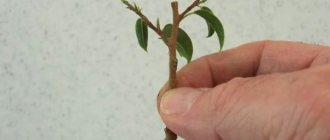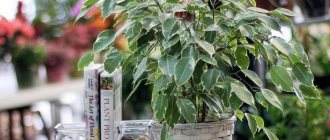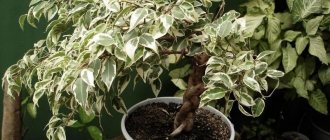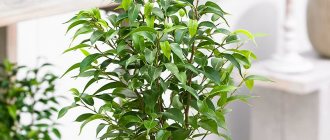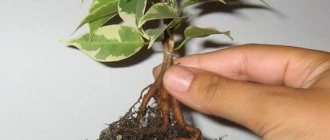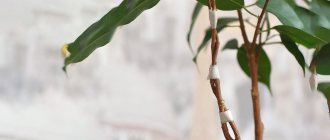Ficus benjamina - a tree-like shrub, originally from the tropics, which, even in an apartment, can grow into a full-fledged tree, 2-2.5 m high. If such a large size is not included in your plans, then its growth can be easily restrained by the volume of the pot and timely pruning. Then it will easily fit on any windowsill.
Despite its tropical origin, the plant is very pliable and does not require special attention at all. Still, Ficus Benjamin has some needs that need to be kept in mind when caring for it at home. By following them, you can grow a beautiful bush or tree, for example, as in the photo below:
Ficus benjamina will not only decorate your home, but also purify the air!
What ficus benjamina can be: varieties and forms
In tropical regions, Ficus benjamina grows outdoors like a regular street tree and can reach 30 m in height. Its ability to tolerate pruning makes it very popular as a hedge plant in California.
Alley of ficus Benjamin
In our latitudes, ficus benjamin is grown in pots and containers. With long branches and glossy green or variegated leaves, this plant can become a real designer decoration for an apartment or office.
At home, with proper care, Benjamin's ficus can also grow into a real indoor tree.
If you do not replant the ficus into a large pot, then it will remain just such a compact plant for the windowsill
Moreover, you can choose from many varieties.
- Traditional varieties with green leaves: Danielle (Daniel), Monique (Monique), Exotica (Exotica), Anastasia (Anastasia).
- Among the variegated (variegated) are especially popular: Starlight (Starlight), Safari (Safari), Nina (Nina).
- And these varieties boast original curled leaves: Barok, Buklee, Iren.
- Small-leaved ficuses also do not give up their positions: Natasja (Natasha), Kinky (Kinky).
Ficus Benjamin - small-leaved variety Kinki
An interesting feature of Ficus Benjamin is the ability of its shoots to grow together upon contact. By planting several cuttings nearby and, as they grow, tying their stems together or braiding them into a braid, rope or openwork design, you get a ficus on a trunk. That is, one tree with an intertwined trunk. You can also grow a ficus on a trunk from one cutting, removing the lower branches as it grows. But such a plant looks simpler and often less original.
In order for the ficus stems to grow together, it is enough to connect them (weave them together or gather them in a bundle) and tie them with thread or wire to fix them. After some time, the shoots will grow together and the clamp can be removed.
Purchase Features
You can buy Ficus Benjamin at any flower shop or greenhouse. There you can find both small neat bushes and plants of more impressive size. The price depends on the variety and size of the ficus. A plant up to 1.5 m high will cost about 4,000 rubles.
Shake your ficus before purchasing. Have you noticed that the leaves are falling? Then it is better to refrain from purchasing. If you want to grow ficus yourself, it’s easier to purchase small cuttings from your hands and start adapting them to the conditions of your home. There is nothing complicated in caring for ficus Benjamin, which is why it is so common among domestic collections of indoor plants.
Flowers on Ficus Benjamin: is it possible?
Ficus benjamina is an ornamental deciduous plant, but it is also capable of blooming. Although this happens extremely rarely at home, as a rule, it blooms and bears fruit in its natural environment or in large greenhouses. He doesn't do this in a standard way. In the ficus Benjamin, like its closest relative the fig, small rounded inflorescence formations appear in the axils of the leaves - syconia, within which flowers are located. Syconias look more like berries than inflorescences, so many people mistake them for fruits. They do not have any special decorative effect, so there is no point in regretting that your Ficus Benjamina does not bloom.
This is how ficus benjamina blooms
Soil requirements, fertilizing and replanting
Soil for Ficus Benjamin can be purchased at the store: for decorative deciduous plants, mulberry plants or palm trees. You can prepare it yourself by mixing deciduous soil, turf, coarse sand and peat with charcoal, respectively, 2:2:1:1. Don't forget to take care of drainage before planting.
Twice a month, except in winter, it is necessary to fertilize the plant, alternating organic and mineral fertilizers. In winter, two feedings are enough for the entire period.
It is better to replant young plants annually in spring (March-April), adult plants - once every three or four years. Each subsequent pot should be a little larger, only 2-3 cm.
How to care for ficus benjamina?
In order for this plant to be healthy, pleased with its glossy leaves and grow quickly, it is necessary to follow some rules of care.
Lighting
Ficus benjamina loves bright, diffused lighting; it looks best on western and eastern windows. If possible, take the plant outside or onto the balcony during spring/summer. Fresh air and plenty of light will definitely benefit the ficus. It will fluff up and accelerate its growth. However, it is better to shade it from direct sunlight, otherwise burns will appear on the leaves.
The variegated (variegated) varieties of Ficus Benjamin are especially demanding when it comes to lighting. With a lack of light, they lose their originality, their foliage becomes ordinary, green.
A caveat should be made here. Ficus benjamina can tolerate poor lighting for some time. That is, it can easily stand in your place somewhere in a dark corner for several months. It will not die, but some of the leaves will lose and their color will become dull. That is, as a necessary measure, temporarily, you can place the ficus in a place with insufficient lighting. But it cannot be placed there on a permanent basis.
Ficus benjamina should be placed closer to the window
Temperature
Ideal temperatures for Ficus Benjamin are 16-24° C. But deviations from this range by 4-5 degrees in one direction or another will not cause any particular harm. Try not to let the temperature drop below 10° C, otherwise the ficus will most likely begin to lose leaves. Not necessarily though. If your plant is acclimatized and hardened, then there may not be any negative effects even if the temperature drops to 5° C.
Note!
In winter, protect Ficus Benjamin from drafts. Make sure that it does not blow from an open window if it is frosty outside. Almost certainly, after frostbite, the ficus will drop all its leaves. And it will grow them again only in the spring. Best case scenario. At worst, the plant may die.
Watering and humidity
It is necessary to water Ficus Benjamina at home sparingly, since excessive soil moisture often leads to rotting of the root system. Between waterings, the soil in the pot should dry out by 1-2 cm. In winter, more drastic drying can be allowed.
For irrigation, use only warm, settled or boiled water. And this is a very important condition. Ficus benjamina is very sensitive to chemical impurities that tap water contains, such as chlorine and fluoride. Therefore, it is necessary to either settle the irrigation water (at least 8 hours) or boil it.
Another important parameter for the health of Ficus Benjamin is high air humidity. In summer and when central heating is on, regularly spray its leaves with warm water. In autumn, on cold days, when the heating is not working or is not turned on at full power, spraying should be avoided.
Spraying Ficus Benjamin is an essential part of caring for it.
Note!
In winter, do not place Ficus Benjamin near radiators. Too dry air causes leaves to fall.
Soil and replanting
The most important requirement for soil: its good water and breathability properties. When watering, water should flow quickly through the drainage holes, without stagnating near the roots. If the soil is too heavy and retains moisture for a long time, the roots of the ficus may suffer from putrefactive processes.
The growth rate of Ficus Benjamin, which lives in a pot at home, is relatively slow. Therefore, young plants are traditionally transplanted into a larger pot once a year, in the spring. Adult plants need replanting much less often - once every 3-4 years.
About ficus transplantation and further care for it, watch the video:
What to feed?
In the spring-summer period (from March to September inclusive), the Benjamin ficus enters a phase of active growth: foliage grows and young shoots appear. All this requires nutrition, which may not be enough in the soil. Therefore, to ensure full development of the ficus at this time, feed it with fertilizer with a high nitrogen content every 1-2 weeks. In stores, such fertilizers are usually sold with the note “for decorative deciduous plants.” There are also fertilizers specially designed for ficus, for example, Agricola - “For ficus” with a ratio of 23:10:16 (N:P:K).
You can feed ficus with any fertilizer with a high nitrogen content.
Note!
Root fertilizers are applied in moist soil. That is, first you water the plant with clean, settled water, and after 15-20 minutes - with water with diluted fertilizer. This approach will reduce the risk of chemical burns to the roots.
In autumn and winter, Ficus Benjamin, growing at home, does not need to be fed, since all vital processes slow down during this period. The plants enter a resting stage.
Description of the plant, interesting facts
There are a lot of varieties of Benjamin ficus, they all grow in the tropical zone, so caring for them requires attention and skill. If you grow a plant from a cutting at home, it will be more adapted to local conditions. The specimens that take root the worst are those purchased as adults. Most often, they shed their foliage when growing conditions and care methods change, then grow new greenery.
In the culture of Southeast Asian countries, ficus benjamina receives increased attention. In Thailand it is considered a sacred plant. According to legend, the tree is capable of increasing the strength of the family. The wood and leaves are used to prepare medicines for female diseases.
Pruning and shaping Ficus Benjamin
Ficus easily recovers after pruning; this manipulation causes almost no stress to it. Therefore, if you see that your plant is growing one-sided, don’t be afraid to cut off the branches that are out of the general “picture”. Pruning is also necessary to adjust the height of an oversized ficus.
The pruning technology is very simple: take a sharp, clean knife (secateurs, scissors) and cut off excess shoots; Make the cut above the internode with the growth point - after a while new shoots will emerge from the axils.
It is best to prune Ficus Benjamin in early spring, when the plant begins to awaken from winter hibernation. In this case, it will quickly develop the required shape. The so-called sanitary pruning (removal of dry, diseased branches) can be carried out at any time of the year.
An example of anti-aging ficus pruning is shown in the video:
But pruning is only one of the stages in the formation of Ficus Benjamin. Flexibility, the ability to grow shoots together, quick recovery after pruning - all these characteristics make this plant an excellent object for the gardener’s creative experiments.
Using methods of formative pruning and merging of trunks, you can grow Ficus Benjamin:
- In the form of a bush - then you plant the cuttings in one pot and they grow in their natural form, pruning is limited to “straightening out” the shaggy branches.
Ficus benjamina is the easiest to form in the form of a bush.
- On a trunk - the cuttings are braided (with a braid, a rope, an openwork hollow structure) or tied into one trunk, or a trunk is grown from one plant, removing all the growth on the trunk being formed.
Various options for Ficus Benjamin on a trunk
- In the bonsai technique , a complex method of obtaining a tree “in miniature” is achieved by step-by-step pruning of the roots and crown of the plant, as well as other manipulations that inhibit growth.
Ficus benjamina bonsai
Reproduction
Ficus benjamina is propagated by cuttings.
The best time for this is spring, when it becomes warm and all processes in the plant body proceed at an accelerated pace. But still, the process of root emergence in Ficus Benjamin cannot be called quick. Under favorable conditions (warmth, favorable humidity), spring cuttings take root in 2-3 weeks. In more difficult conditions, this process can take a month or more.
To propagate Ficus Benjamin by cuttings, do the following:
- Using a sharp knife, cut the apical young cuttings (non-lignified or semi-lignified) from the plant. The length of the cuttings should be 10-15 cm.
- A milky juice is released at the cut site - rinse it off under running water or immediately place the cutting in a glass of water for 1 hour. Then dry the cut in a dry place for several hours. Milky sap inhibits the emergence of roots in ficus, so you should not neglect to wash it off.
- Tear off the lower leaves on the cutting. When buried in soil or water, these leaves will most likely begin to rot, thereby spreading bacteria to the rooting cutting.
- To stimulate the formation of roots and make this process faster, dip a cut of the cutting in Kornevin. This stage is not mandatory, but highly desirable, especially in non-ideal rooting conditions.
- Place the cutting in warm water or bury it 1.5-2 cm in the ground. A more successful soil option is peat tablets, in which roots form faster.
- To root cuttings, choose a warm (more than 25°C) and bright place, without direct sunlight. High air humidity is also important - ideally about 80%. To increase this parameter, the easiest way is to build a greenhouse over the rooted cuttings, that is, cover it with a plastic cup, bag, etc.
After cutting, ficus cuttings are buried in the ground, where they will take root
. For reference:
In autumn and winter, the rooting of any plants, including ficuses, may not take place at all. At this time, the plant is preparing or is already dormant; another unfavorable factor is cold. The cutting will be in a half-asleep state and will most likely rot.
Possible problems with Ficus Benjamin
Leaves are falling. Benjamin's ficus immediately reacts to almost any errors in care by dropping its leaves. This could be a sudden cold snap, a draft, a change in location, flooding or dryness, lack of lighting, or a transplant. Leaf fall can also begin for completely natural reasons - during the autumn period of transition to a state of dormancy. Like shrubs in nature, Benjamin's ficus can shed some of its foliage, which is difficult to “feed” when daylight hours decrease and temperatures drop.
The leaves are turning yellow. The reasons are the same. As a rule, the foliage on the Benjamin ficus first turns yellow and then falls off. That is, all the reasons leading to leaf falling and listed in point 1 also apply to sudden yellowing. In addition, yellowing may be due to a lack of nutrients in the soil and pest invasion (in particular, spider mites).
The leaves are drying. If only the tips of the leaves dry, this indicates low air humidity. This is usually observed in winter, when the batteries are turned on. To fix the problem, spray the ficus with warm water every day or use air humidifiers (electric or in the form of containers hung on the radiator). If the leaves dry not only from the edges, then the reasons may be more serious: waterlogging, frostbite, fungal disease, overdose of fertilizers.
Ficus doesn't grow. Most often the problem is associated with a pot that is too small, which inhibits the growth of the root system. The roots do not develop, and the upper part stops growing along with them. There are other possible reasons for this phenomenon. For example, root growth is inhibited due to too heavy soil or infrequent watering, which turns the soil into “stone.” The roots are not able to pass through the rocky barrier and stop growing.
Pest attack. Ficus plants are often attacked by mites, aphids and scale insects, so if the plant suddenly begins to look sickly, inspect it for the presence of these parasites.

